
Bristol - Brislington
Brislington's history can be traced back to Roman times. In 1899 when Winchester Road was being built, workmen unearthed the remains of a villa. It is believed to have been destroyed by fire around 367AD.
In medieval times, the Chapel of St. Anne in the Wood become the third most important place of pilgrimage in the country. It was twice visited by King Henry VII, in 1486 and again in 1502. The association is still found in the name of the Pilgrim pub and Holymead schools.
Travelling out from Temple Meads along the A4, Bath Road you come across this old turnpike building, now a pub, called appropriately enough The Turnpike
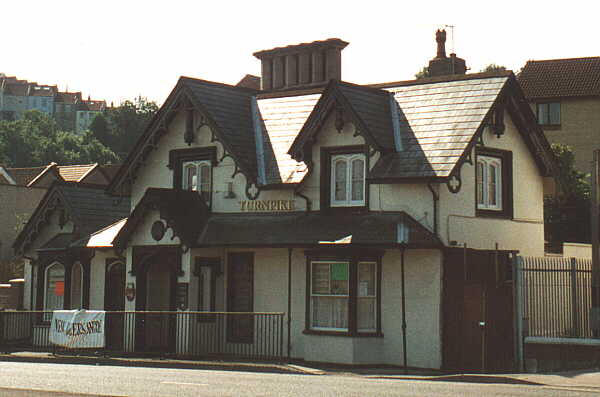
The Turnpike
A little further along the road to the left of the pub is the very steep set of steps that lead up to Totterdown, these are the Thunderbolt Steps.
A little further along the road out of Bristol from Arno's Vale cemetery on your left can be seen the Black Castle.
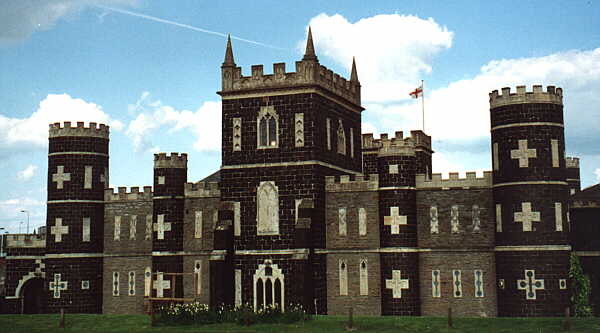
Despite its looks this isn't a castle at all, it isn't even that old, well, it is old but not as old as it looks. Built in the 1760's it started life as a stable. The black colour of the blocks it's built from is due to the fact that they were made from coalmine and brassmill waste. The man who had it built lived across the road in Arno's Manor. This building has been a pub for many, many years.
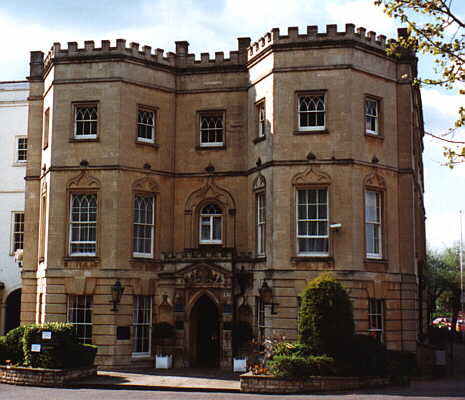
Arno's Court House
This building is now a hotel but has an interesting history. Between 1851 and 1948 it was the Good Shepherd Convent. The following comes from a query sent to the Clifton Cathedral site.
Arnos Court: Good Shepherd Convent 1851-1948
The convent was founded in July 1851 and only two months later received a visit from Cardinal Wiseman. 'The Good Shepherd Sisters had arrived in England from their Mother Homes in Angers, France in May 1841 and opened a convent and Home for Women in Hammersmith, London. The Bristol property at Arnos Court was purchased for the sisters by William Austin Gillow who, having visited the Hammersmith convent and seen the good work done for women who had been brought from a life on the streets, 'desired earnestly that a similar house be set up in Bristol for the same purpose'. Gillow was a member of an old Lancashire Catholic family who married Miss Agnes Markland of Pemberton Villa, Clifton Park, in 1851. Included in the gift was the land which is now the Cemetery of the Holy Souls.
At first a room in the house was used as a chapel, but in May 1858 the foundation of the present building was laid, and the completed building was dedicated by Bishop Clifford in March 1859. By that time the sisters had spent large sums in the erection of' buildings, including a laundry. Bishop Clifford took a great interest in the chapel, to which he was a generous benefactor, his gifts including a chalice given to him by Pope Pius IX, and the four marble pillars, still to be seen in the present day restaurant, which divided the sanctuary from the sisters' choir. The first apostolic work established in Arnos Court was the traditional one of the sisters, a Voluntary Home for older teenagers and women who had personal and social problems. Their ages could range from seventeen to forty years.
Later, in 1856, another apostolate was started. In view of the great need in England for a home for Catholic girl ex-prisoners, the ecclesiastical authorities asked the Provincial Superior of the Good Shepherd Sisters to consider undertaking the direction of a Reformatory School instead of the Voluntary Home in Bristol. At this time child offenders as young as nine years of age were being sent to prison to serve time in hard labour followed by a specified time in Reformatory Schools. Since there was no such provision for Catholic girls they were being sent to non-Catholic establishments.
After due consideration, and because the number of 'women seeking places in the Voluntary Home had decreased, it was agreed that this new apostolic work for girls be undertaken. The Certificate of Registration for Arnos Court as a Reformatory School for Catholic girls up to the age of sixteen was accorded by the Home Office on 22 April 1856. Thus was Arnos Court Reformatory School, known as St. Joseph's School, established and it was to continue uninterrupted under the direction of the Good Shepherd Sisters through the statutory changes of name, and changes of location (Eagle House, Bathford, and Ashwicke Hall, near Chippenham) from that day until November 1986.
The two separately run apostolates flourished for many years. During the wartime blitzes on Bristol in 1940 and 1941 the property suffered so severely that it was estimated that more than two-thirds had been destroyed. The Home Office insisted that the School be evacuated to a safer area. After much search Eagle House, Bathford was found and accepted by the Home Office as being suitable. On 3 March 1941 two sisters left Arnos Court with twenty of the girls for their new temporary home. Three days later they were joined by four more sisters, seven auxiliaries and the remaining sixty girls. By this time the name Reformatory School had give way to that of Approved School.
Eagle House is a lovely Georgian residence suitable for a family of eight or ten to live in some style. Now it was being called upon to accommodate six sisters, seven auxiliaries and eighty girls. However, it was seen as welcome after months of living and sleeping in underground shelters. Bishop Lee offered the first Mass there on 7 March and then consecrated the house to the Sacred Heart. There followed a very difficult period of adjustment during which a Horne Office Inspector allowed the registered number, as a concession to the cramped accommodation, to be reduced from eighty to seventy-two.
After a very severe bombardment on the night of l0 September 1943 the sisters decided to sell Arnos Court and look for another property. It was a sad decision as the house had been established in the lifetime of the Foundress, St. Mary Euphrasia Pelletier.
Hill End House: Henbury, Bristol 1948 - I976
This property on the outskirts of Bristol received three sisters and a few girls in September 1946. When the necessary alterations had been completed the rest of the community and girls joined them on 28 October 1948. This date also marked the closure, after ninety-seven years, of the original Bristol foundation at Arnos Court. Later a second apostolate, for unmarried mothers was initiated in Henbury in the newly acquired Severn House. It became known as St. Raphael's Mother and Baby Home. This work continued until November 1976 when it was closed and the sisters withdrew.
From "The Diocese of Clifton 1850-2000 - A Celebratory History of Events and Personalities" - Clifton Catholic Diocesan Trustees, 1999 - ISBN 0 9536689 0 8
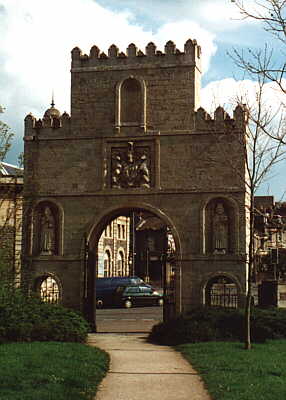
The original entrance arch to the Arno's Estate
This 18th century arch was designed by William Bridges. The original statues were those from Newgate and Lawfords' Gate when they were demolished. A plaque on the arch states that it was moved from its original position, as the entrance to the Black Castle stables, in 1912 and was fully renovated in 1995.
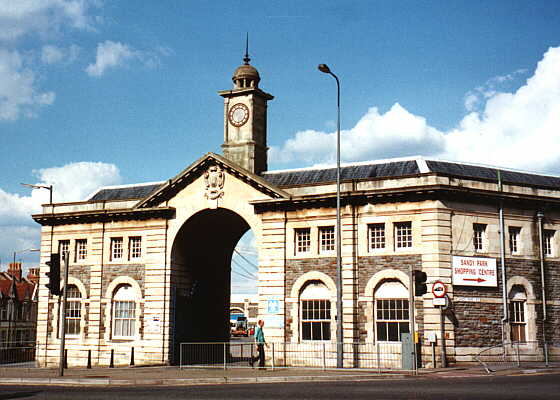
The old tram depot
Just across the road from the arch, and lying at the bottom of Sandy Park Road, is this building. Now a council vehicle depot it was, at one time, one of the main tram depots for Bristol.
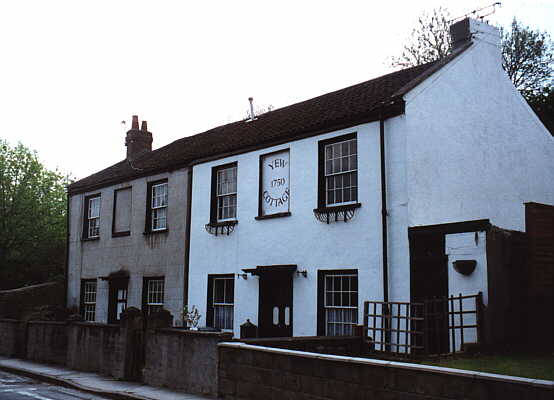
Yew Cottages
Tucked out of the way in Hollywood Road, lie Yew Cottages. These tiny houses were built in 1750.
Here's an interesting story - and a mystery. This comes from "Bristol Curiosities" by Reece Winstone & Glyn Duggan, published in 1979 by Redcliffe Press.
The churchyard of St. Luke's, Brislington, has a most intriguing tombstone. According to its inscription, it commemorates Thomas Newman who died in 1542, aged 153. Such an age seems unlikely in the extreme. However, the churchyard in Bridlington, in Yorkshire, also has a stone which reads: "Thomas Newman, aged 153 years. This stone was refaced in 1771 to preserve the recollection of this remarkable prolongation of human life", and goes on to say: "The above is a copy of an inscription on an ancient stone in Bridlington churchyard which has now disappeared."
It seems to be stretching credulity much too far to believe that in both Bridlington and Brislington a baby named Thomas Newman who would be born in 1389 and live through 153 turbulent years to die in 1542. Can the stone in Brislington churchyard be in fact the original one which disappeared from Bridlington? Even so, the wording on the Bristol stone is not quite the same as that quoted as having been on the Yorkshire one. Can our stone too be a copy, perhaps imperfect, of the original one? And who might have been responsible for placing the stone in the other churchyard? Did Thomas Newman ever even exist, let alone live through eight reigns? A puzzle indeed.
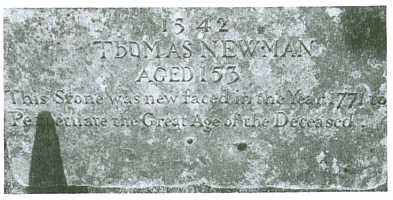
This page created 9th May 2000, last modified 25th April 2008